The 20 Best Hotel Pricing Strategies to Increase Your Revenue in 2025
Jul 27, 2025
 Mika Takahashi
Mika TakahashiPopular Categories
Hotel Technology & InnovationHotel Operations OptimizationDigital MarketingIndustry TrendsRevenue ManagementHospitality Industry
Popular Categories
Trending Post
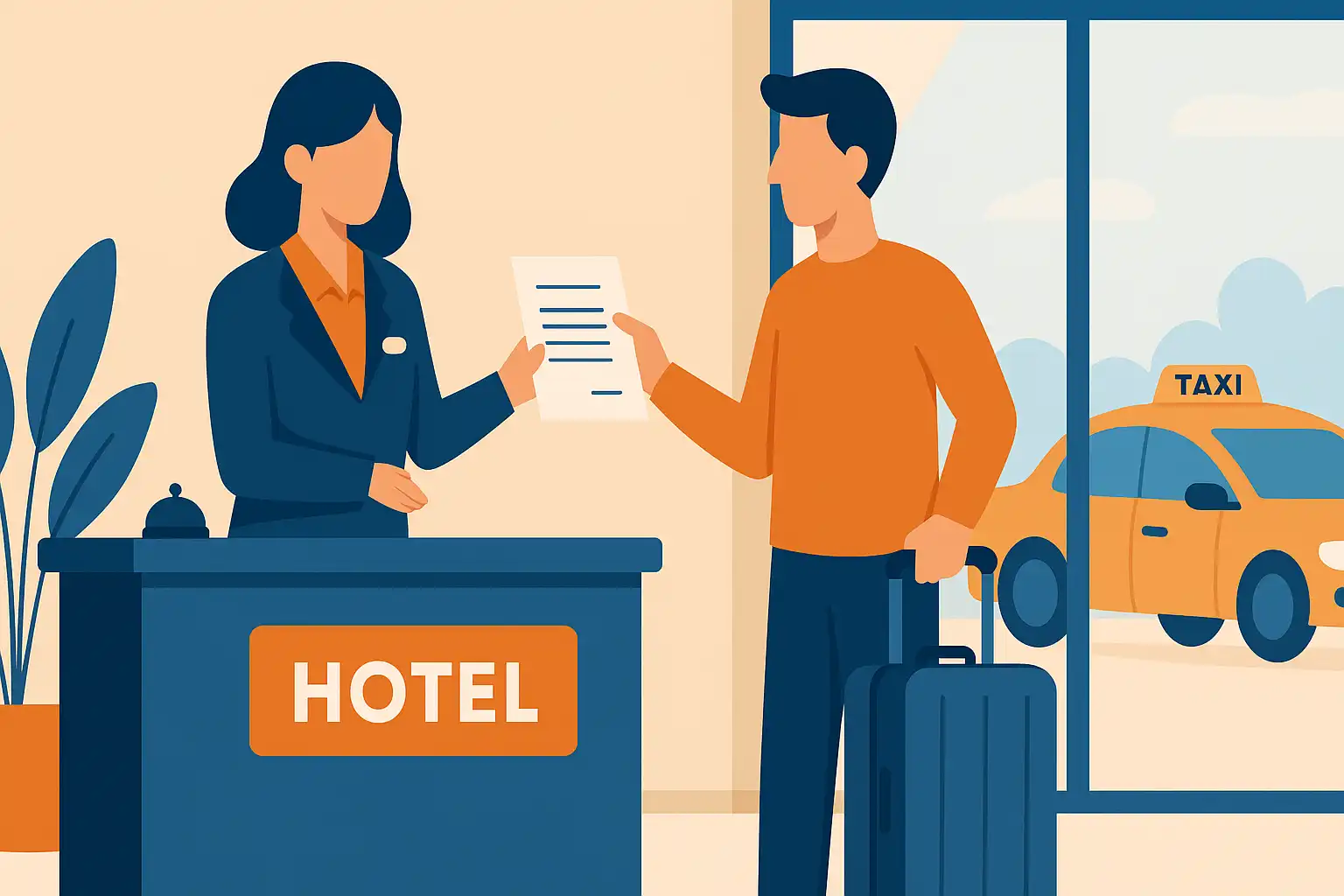
Hotel Walk Letter Template: Professional Guest Communication
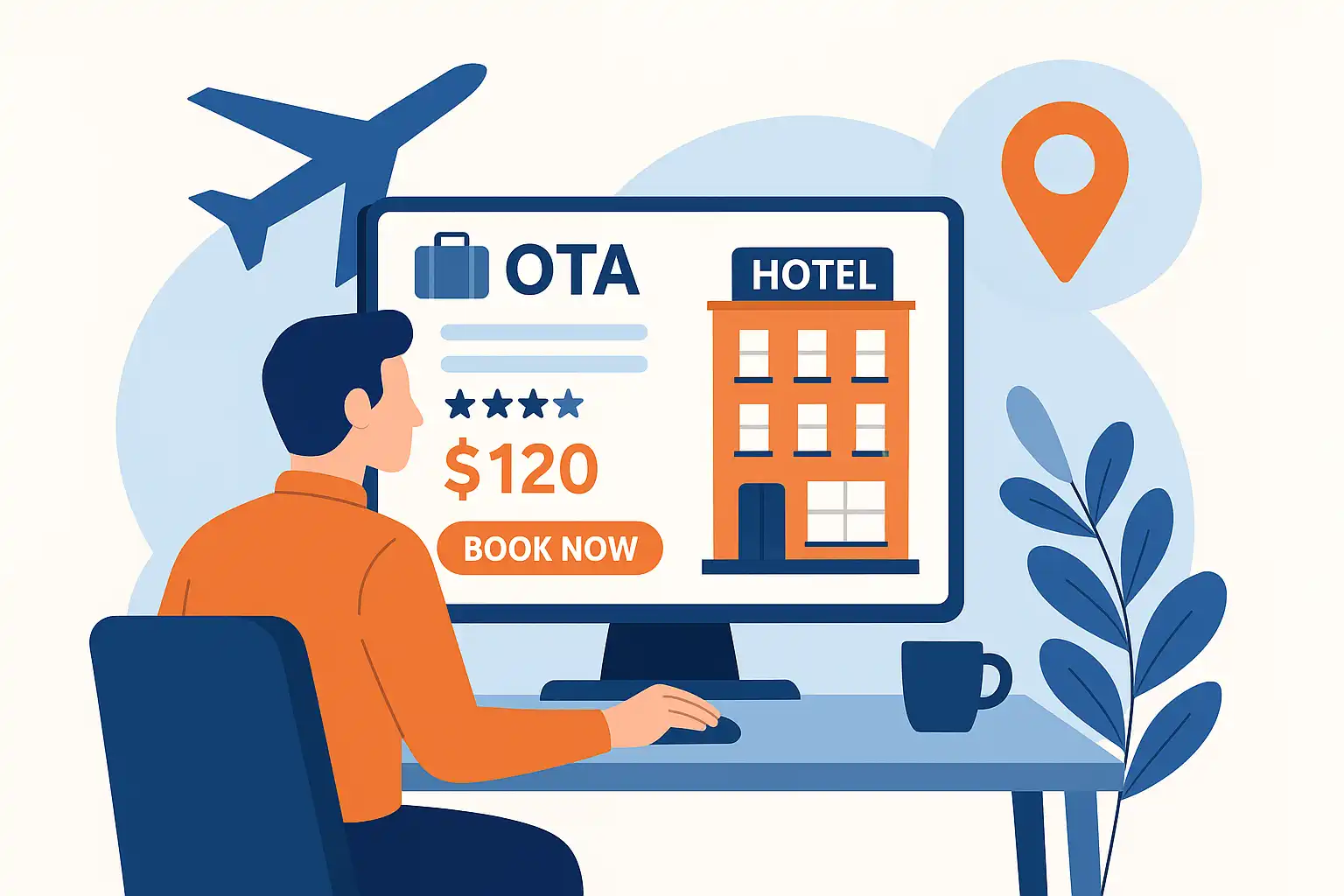
Online Travel Agents: What They Are and How They Work
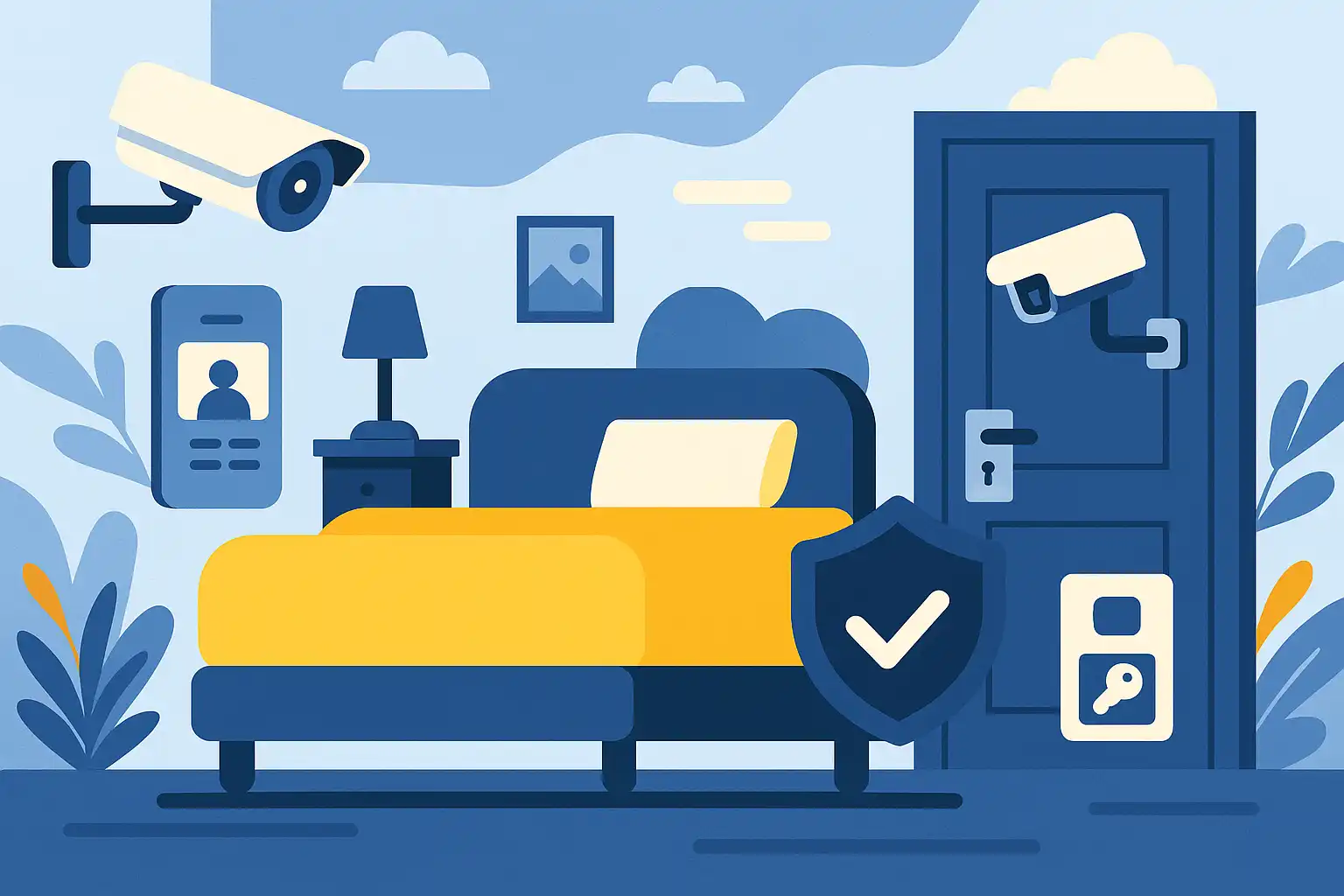
Hotel Security Systems: Modern Protection Solutions

Hotel Advertising: Complete Guide to Boost Bookings and Revenue
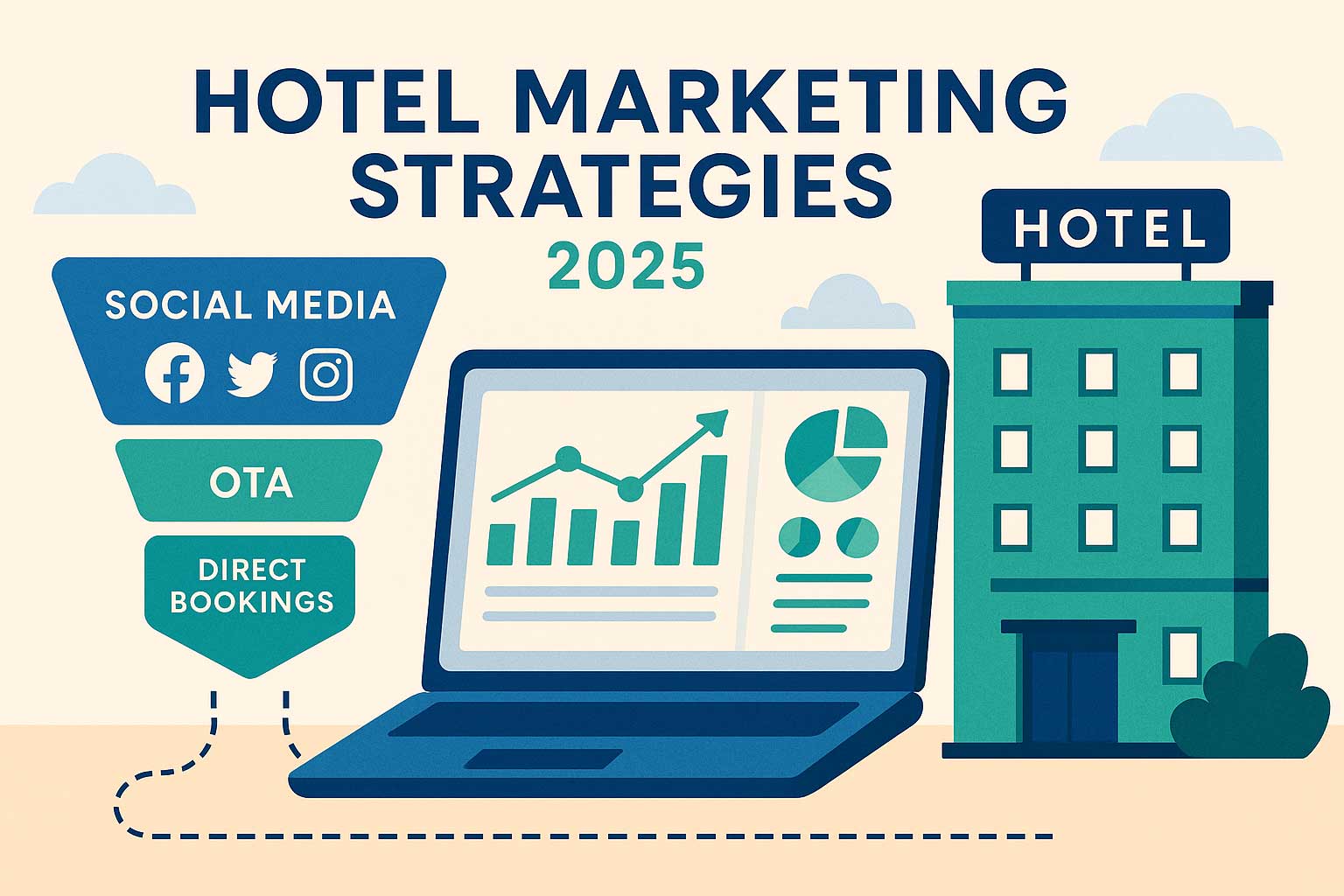
25 Hotel Marketing Strategy Ideas for 2025: Complete Guide

AI Reservation Agent: Revolutionizing Hotel Booking and Guest Experience

PMS Communication: Streamlining Property Management Through Effective Guest Messaging
Table of contents
A single pricing decision in the hospitality industry determines whether a hotel will achieve profitability or experience revenue loss during a quarter. Hotels must move away from using fixed room rates and instinctive rate adjustments because travelers now focus on prices and the market competition has grown stronger across all segments.
Hotel pricing strategy requires market intelligence and guest behavior analysis and advanced technology to maximize every booking opportunity. Hotel managers who oversee independent boutique properties or major chain revenue need to understand strategic room pricing methods to boost occupancy rates while keeping profit margins healthy.
This detailed guide presents established hotel pricing methods which successful properties employ to boost revenue through basic demand-based strategies and complex dynamic pricing systems. This guide shows you how to use multiple pricing strategies while using technology for competitive advantage and how to prevent common pitfalls that decrease profitability.
What is a hotel room pricing strategy?
Hotels use pricing strategies for rooms as a data-based approach to establish rates which maximize revenue while maintaining market competitiveness and guest value perception. A successful hotel room pricing strategy requires the proper management of three essential elements which include profitability together with competitive market positioning and guest-perceived value.
The main goal requires hotels to optimize their key performance indicators which directly affect their financial success.
- Occupancy Rate: Percentage of available rooms sold over a specific period
- Average Daily Rate (ADR): Average revenue earned per occupied room
- Revenue per Available Room (RevPAR): Overall revenue relative to total available inventory
The three metrics function together to deliver a complete understanding of pricing success. The combination of 90% occupancy with low room rates produces less total revenue than maintaining 75% occupancy at optimized pricing levels.
The way hotels price their rooms directly affects their overall operational success beyond short-term revenue generation. Strategic room pricing enables hotels to draw their preferred customer base while shaping online review ratings which boost future bookings and enhances loyalty programs and financial stability during economic challenges and unexpected market events.
How Hotel Pricing Works
The hotel pricing system functions based on basic supply and demand rules which control the entire hospitality industry. Hotels increase their room prices during peak times which include major local events and holidays and high travel seasons because they have limited rooms available to serve a higher number of customers. Hotels decrease their prices during periods of low demand to draw budget-conscious guests while keeping their occupancy rates at a suitable level.
Hotels adjust their room prices through continuous adjustments that depend on supply and demand levels together with competitor pricing and market trends and seasonality and customer behavior. Hotels use dynamic pricing strategies to adjust their prices instantly according to current market conditions which maximizes their revenue potential. The pricing strategy uses historical data together with booking patterns and forecast demand to reach optimal occupancy levels and profit margins. Hotels need to understand both fixed costs and variable costs and guest-perceived value of rooms and extra services to set effective prices.
What should you consider when implementing a hotel pricing strategy?
When implementing a hotel pricing strategy, several factors must be considered to be successful:
- Market demand: Understanding fluctuations in customer demand helps set appropriate room rates.
- Competitor pricing: Monitoring competitor pricing provides insights into local market conditions and helps maintain a competitive advantage.
- Operational costs: Both fixed and variable costs must be accounted for to ensure profitability.
- Distribution channels: Rates should be consistent across all booking platforms to maintain rate parity and customer trust.
- Customer segments: Different guest types, such as business travelers or leisure guests, may require tailored pricing approaches.
- Seasonality and events: Adjusting prices based on peak seasons, holidays, or local events can boost occupancy.
- Length of stay and booking patterns: Applying length of stay pricing can encourage longer bookings and optimize occupancy.
- Pricing compliance: Ensuring transparency, avoiding hidden fees, and adhering to local regulations are essential for customer satisfaction.
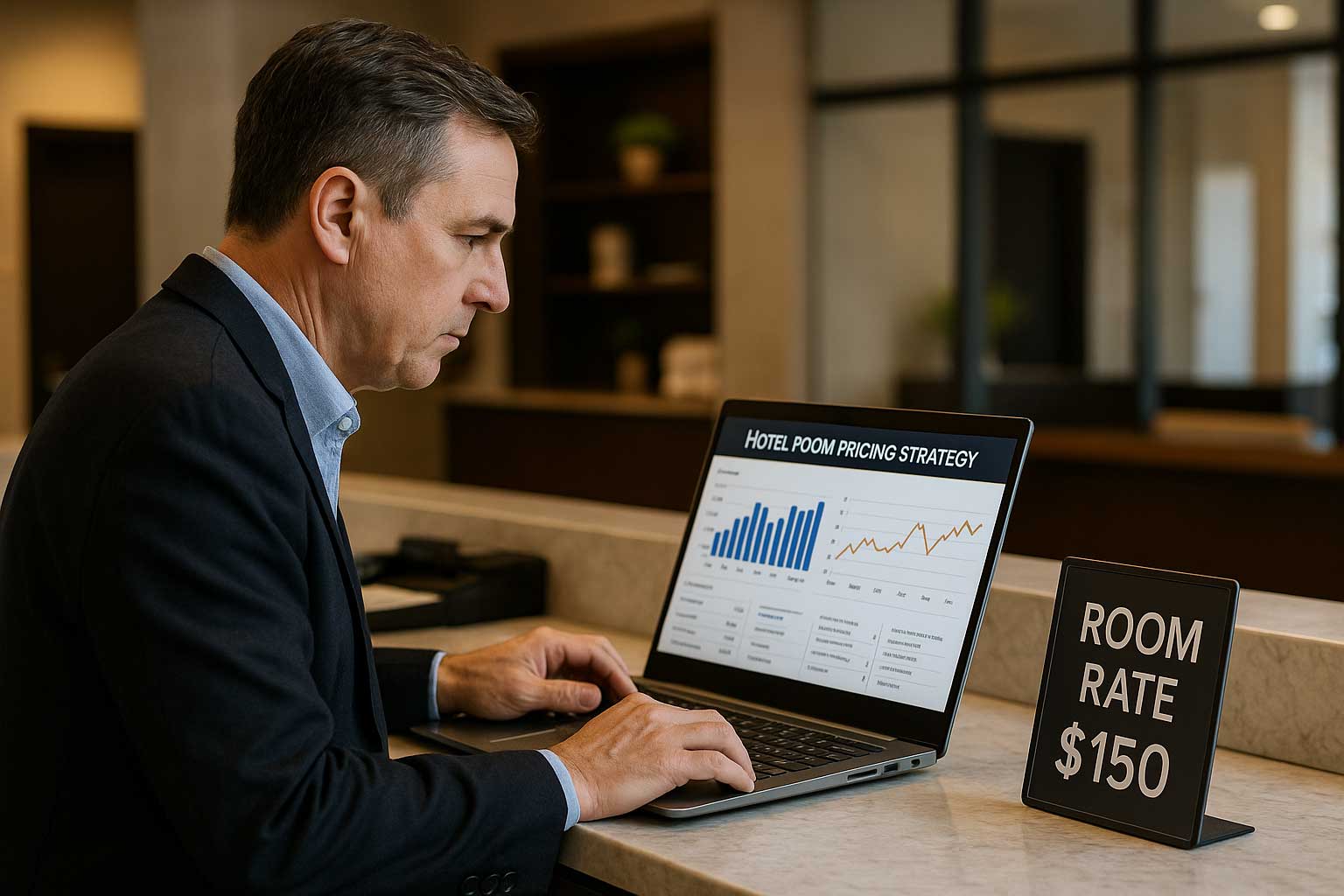
20 Effective Hotel Pricing Strategies to Increase Revenue
1. Competitor-based
The pricing strategy of competitor based pricing sets rates based on competitive set pricing strategies to achieve market position goals. Hotels choose to lead prices or follow competitors or match their prices based on their market value and strategic objectives.
The implementation of this strategy needs advanced competitive intelligence tools which track both rate information and availability data and package deals and promotional activities of your competitive set. The successful execution of this strategy extends past basic rate matching because it demands knowledge about competitors' pricing motivations and the specific features of your property that support premium pricing or value positioning.
The main drawback of competitor-focused strategies occurs when properties start competing mainly through price reductions which creates a market-wide decline in profit margins.
2. Forecasting-based
Hotels use forecasting-based room pricing strategies by analyzing historical data and market trends to predict future demand and occupancy levels. Hotels use past booking patterns and revenue figures together with seasonal fluctuations and local events to forecast high and low demand periods. Hotels use predictive methods to set their room rates in advance so they can maximize revenue during peak times and attract guests during off-peak periods. Accurate forecasting enables hotels to avoid both underpricing during busy seasons and overpricing during low demand periods thus maintaining room rates that match market expectations.
Hotels must track competitor pricing along with economic indicators and upcoming events that affect traveler behavior as part of their forecasting-based strategy. Hotels utilize advanced revenue management systems (RMS) with machine learning algorithms to analyze data points which produce dynamic pricing recommendations. Hotels can enhance their real-time pricing decisions through this method to boost both occupancy rates and profitability. The implementation of forecasting-based pricing enables hotels to better manage their inventory because it helps them predict room availability and optimal pricing points which leads to improved hotel revenue management.
3. Length-of stay
Hotels use Length-of-stay (LOS) pricing as a strategic method to modify room rates according to how long guests stay. The pricing strategy provides discounted rates and special packages to guests who book their stay for multiple nights thus promoting longer bookings. Hotels achieve higher occupancy rates through extended stay promotions which simultaneously decrease room turnovers and reduce operational costs for cleaning and administrative work. Hotels use LOS pricing effectively during peak times and special events because they can establish minimum stay requirements to achieve maximum revenue and control room availability.
Hotels need to perform detailed market demand and booking pattern assessments before implementing length-of-stay strategies. Hotels establish their minimum and maximum stay requirements and pricing levels through analysis of past reservation data and market demand forecasts. A hotel implements three-night minimum stays during festival weekends to maintain stable occupancy but provides week-long discounts during slow periods to draw longer-staying guests. The adaptable pricing system enhances hotel occupancy levels while improving inventory management and revenue forecasting which makes it an essential part of hotel pricing strategies.
4. Segment-based
Hotels use segment-based room pricing when they split their market into distinct customer groups through characteristics such as demographics and booking patterns and travel purposes and spending behaviors. Hotels use segment understanding to develop pricing strategies which fulfill the payment potential of each customer group. Business travelers show less price sensitivity because they want flexible booking options with premium amenities while leisure travelers seek budget-friendly packages that offer extended stays. Hotels achieve better revenue through this targeted pricing method because it extracts maximum value from each customer segment instead of using a generic pricing approach.
Hotels need strong data analysis capabilities to detect various guest segments while tracking their booking behaviors for successful implementation of segment-based pricing. Hotels develop tailored offers and room types and pricing tiers which specifically target each guest segment to boost perceived value and boost booking conversion rates. Hotels can use segment-based pricing to modify their marketing strategies and distribution channels which ensures appropriate messages find their intended audiences. The strategic implementation of segmentation leads to higher occupancy rates and revenue growth while delivering better customer satisfaction through tailored options that match individual preferences.
5. Guest type-based
Hotels use guest type-based pricing to establish different room rates for various guest categories based on their characteristics and booking behaviors. The pricing strategy acknowledges that different guests demonstrate varying levels of payment willingness and different booking habits. Business travelers seek convenient accommodations with flexible policies and additional amenities so they pay higher rates for spontaneous bookings and adaptable cancellation options. Leisure travelers tend to be price-conscious and they book their trips ahead of time which makes them more likely to respond to early-bird discounts and package deals. Hotels achieve maximum revenue through this segmentation approach because they set prices that match each guest group's perceived worth and requirements.
Hotels need to perform detailed data analysis and create customer profiles to identify distinct guest segments including families and solo travelers and corporate clients and international tourists. Hotels should create special pricing deals and flexible room rates and targeted promotional offers which focus on specific guest groups. Hotels increase bookings from families by offering discounted rates and additional perks during school holidays yet they use premium pricing with business-focused amenities to attract corporate guests. The strategy both boosts revenue and improves customer satisfaction because it delivers personalized experiences which leads to increased repeat stays and long-term loyalty.
6. Occupancy-based
Hotels use occupancy-based room pricing strategy to change their rates based on how many guests are currently staying in their properties. Hotels can boost their revenue through higher room prices when occupancy rates remain high because demand is strong and rooms are scarce. Hotels adjust their prices downward when occupancy rates are low to draw in additional guests and increase their bookings. Hotels use this strategy to optimize revenue through supply and demand principles by raising prices during room shortages and lowering prices during room abundance.
Hotels need to track booking patterns and analyze real-time data to adjust their room prices through an occupancy-based pricing system. Hotels implement revenue management systems (RMS) to automate their processes which enables them to quickly respond to occupancy changes across different distribution channels. The pricing strategy improves profitability while maintaining suitable occupancy levels which minimizes the chance of unsold rooms. Hotels can enhance their pricing decisions by integrating occupancy-based pricing with length-of-stay restrictions and segment-based pricing to effectively serve different guest segments.
7. Incentive-based
Hotels use incentive-based room pricing strategies to provide special rewards and discounts which encourage guests to book directly through the hotel or to return for future stays. The strategy uses promotional offers including time-limited discounts and coupon codes and bundled packages and loyalty program benefits to deliver extra value beyond standard room pricing. Hotels use these incentives to differentiate from competitors while drawing price-conscious customers and boosting direct bookings which produce higher profits because they avoid commission fees from third-party booking platforms.
The strategy builds strong guest relationships through loyalty rewards and repeat business promotion. Hotels provide exclusive discounts to repeat guests and offer early check-in and late check-out benefits and free room upgrades when guests book directly. The pricing strategy allows hotels to customize their offers for different customer groups including business travelers and families through targeted promotions that fulfill their distinct requirements. The successful implementation of this strategy leads to higher occupancy rates and revenue growth while improving customer satisfaction and building lasting brand loyalty which makes it a vital element of a complete hotel pricing strategy.
8. Loyalty-based
The loyalty-based hotel room pricing strategy provides exclusive discounts and special rates and added perks to members of the hotel's loyalty program as a way to reward repeat guests and encourage customer retention. The approach drives guests to book directly with the hotel thus increasing direct bookings and reducing third-party platform commissions while building long-term relationships that generate steady revenue.
Hotels that customize their pricing and benefits for loyal customers will increase customer satisfaction and brand loyalty which creates a sense of value and appreciation that leads to guest retention. Hotels can optimize their revenue and occupancy through loyalty-based pricing when they combine it with incentive-based offers and segment-based pricing to maintain their competitive position in the hotel industry.
9. Cancellation policy
Hotels implement a pricing strategy based on cancellation policies which determines room rates according to booking flexibility terms. Hotels provide lower room rates through non-refundable booking policies to encourage guest commitment since this approach minimizes the risk of last-minute cancellations that result in revenue loss. Hotels price their rooms higher when they offer flexible cancellation terms because these policies create uncertainty about potential cancellations that result in revenue losses.
Hotels use this pricing strategy to control their demand while reducing revenue loss by offering price-sensitive guests strict terms and flexible guests higher rates. Hotels find this approach most effective during peak demand times because it helps them secure confirmed bookings and they can use it alongside dynamic pricing and length-of-stay restrictions to maximize occupancy and profitability.
10. Upselling
Hotels use upselling as a pricing strategy to boost booking revenue through guest purchases of upgraded services during the booking process or at check-in. Hotels use this strategy to offer guests room upgrade options to suites or better view rooms and additional services including early check-in and late check-out and enhanced amenities and bundled packages that include dining and spa treatments and local experiences. Hotels can boost both guest satisfaction and revenue through the strategic presentation of additional value-added options to their customers at the right time.
The practice of upselling generates higher profits while creating satisfied guests who become loyal customers through customized service delivery. The success of upselling depends on staff training combined with strategic communication and technology tools that integrate with the property management system to detect opportunities and deliver suitable offers at appropriate times.

11. Cross-selling
Hotels use cross-selling as a pricing strategy to boost total revenue by promoting supplementary products and services to their room booking customers. The main difference between upselling and cross-selling exists in their approach since cross-selling presents additional experiences like spa treatments and dining options and local tours and airport transfers and event tickets to guests at any point during or after their booking process. The hotel benefits from this strategy because it provides guests with easy access to multiple amenities and activities while increasing revenue from each guest.
The success of cross-selling depends on individualized communication and prompt offers and booking system integration to provide suitable add-ons that match guest interests and past bookings. Hotels can enhance profitability and customer satisfaction and build loyalty through cross-selling because it provides guests with a complete and memorable hotel experience.
12. Rate-parity strategy
Hotels use rate-parity strategy to set identical room prices across their website and all distribution channels including OTAs and third-party platforms. The practice of maintaining uniform room rates across all booking platforms creates customer trust because it guarantees equal prices no matter the booking source thus strengthening hotel credibility and minimizing guest confusion. Hotels need to handle rate parity carefully because it supports transparent pricing yet they must manage OTA commission expenses against direct booking promotions.
Hotels use exclusive offers and loyalty programs to promote direct bookings because these strategies enhance profit margins without violating rate parity agreements. Hotels need to maintain rate parity because it protects their brand reputation and prevents distribution partner conflicts while ensuring contractual compliance thus making it vital for hotel pricing strategies.
13. Seasonality-based
Hotels use seasonality-based room pricing to change their rates based on expected yearly demand patterns that include tourist seasons and holidays and local events. Hotels use historical data analysis and market trend research to determine peak demand periods for price increases and low demand seasons for promotional pricing to boost occupancy.
Hotels use this pricing approach to maximize revenue by raising rates during busy times while maintaining consistent bookings during less busy times. Hotels use seasonality-based pricing together with other strategies including length-of-stay restrictions and package deals to boost profitability while targeting different guest segments across the entire year.
14. Psychological pricing
Hotels use psychological pricing as a strategic method to make their room rates more appealing to potential guests through psychological manipulation. Hotels use pricing strategies like $199 or $199.99 instead of $200 per night to create an illusion of better value for their guests. The pricing technique works by targeting consumer attention to the first digit of prices which makes them believe the total amount is lower than it actually is. The pricing strategy of setting rates below whole numbers works as a booking motivator because it makes customers believe they pay less than they would with a standard price.
Hotels that implement this strategy with care will make their offerings seem more valuable to customers which leads to higher booking rates and increased revenue without changing their actual prices. The pricing method proves most effective when used together with value-added pricing and promotional discounts to develop attractive offers that match customer spending patterns and expectations.
15. Package pricing
Hotels use package pricing as a strategy to combine room rates with additional services and experiences into single attractive offers for their guests. Hotels use this method to boost their offerings' perceived value through bundled services which include meals and spa treatments and airport transfers and local attraction tickets. Hotels use package deals to enhance both their booking revenue and market differentiation through their competitive environment.
Package pricing attracts guests who want easy travel solutions and complete vacation packages which leads them to extend their stays and spend more money. Hotels can better control their inventory through package pricing because it promotes underutilized services while driving customers to book directly. Hotel revenue management benefits from package pricing when it is implemented correctly because it leads to higher customer satisfaction and increased average guest spending.
16. Weekend pricing
Hotels use weekend pricing as a strategic approach to set different weekend rates than weekday rates which typically increases prices on Fridays through Sundays. The pricing strategy takes advantage of weekend leisure travel demand because more people choose to book weekend stays for short trips and special events. Hotels located in busy weekend destinations including beach resorts and urban areas with nightlife benefit from weekend pricing because it allows them to generate maximum revenue during peak times.
Hotels reduce their weekday rates to attract business travelers and midweek guests while maintaining weekend prices to maximize revenue during peak periods. Hotels need to analyze booking patterns and local market demand and competitor pricing before implementing weekend pricing to achieve competitive and profitable rates. The revenue increase from this approach leads to longer weekend stays which results in better occupancy rates and guest satisfaction.
17. Group pricing
Hotels use group pricing as a strategy to provide discounted rates and special packages for bookings that include multiple rooms or guests who typically consist of families or corporate events and weddings and tour groups. Hotels benefit from group pricing by attracting more guests through attractive discounts for large groups while also simplifying their reservation management through group leaders. Hotels benefit from group pricing because it increases revenue through simultaneous room occupancy while encouraging guests to extend their stays and use additional hotel facilities including catering and event spaces and amenities.
Hotels must evaluate group size and type along with seasonal demand patterns and segment impact when implementing group pricing strategies. Hotels with event hosting capabilities and group tourist traffic can use this pricing strategy to optimize their inventory and achieve maximum revenue.
18. Cost-plus pricing
Hotels use cost-plus pricing as a simple pricing strategy to determine room rates by adding a profit margin to the total costs of room provision including fixed expenses and variable expenses. The method provides complete coverage of operational expenses and generates consistent profits which makes it suitable for budgeting and financial planning. The cost-plus pricing method provides price setting clarity but it fails to consider market demand and competitor prices and customer payment willingness which restricts its ability to maximize revenue.
Hotels implement cost-plus pricing as their base pricing strategy while using dynamic pricing methods to achieve market competitiveness and revenue maximization in changing market conditions.
19. Open pricing
Hotels use open pricing as a flexible room pricing strategy which enables them to establish different rates through various distribution channels and room categories and specific dates without following fixed pricing tiers or structures. Hotels can use this method to optimize revenue through real-time market demand adjustments and competitor price monitoring and booking pattern analysis. Hotels using open pricing can test numerous price levels to provide competitive rates on specific channels for price-conscious guests while keeping premium prices on different channels.
Hotels need to monitor their pricing closely because rate disparities can create guest confusion and violate rate parity agreements. Hotels that effectively manage open pricing strategies achieve maximum profitability through their ability to seize additional revenue streams while adapting quickly to market changes.
20. Market-based
Hotels use market-based pricing strategy to determine room rates through analysis of local market conditions and competitor pricing levels. Hotels need to track their competitive environment by studying how similar hotels in the area set their prices and offer promotions and manage their occupancy rates. Hotels can optimize their room rates through market understanding to attract guests while achieving maximum revenue. Hotels adjust their rates through market-based pricing by considering supply and demand patterns along with economic conditions and seasonal market trends.
Hotels use this strategy to stay competitive through market-based pricing which matches their rates to customer willingness to pay thus avoiding both overpricing that leads to lost bookings and underpricing that results in missed revenue opportunities. The strategy proves most effective in competitive and fast-changing markets because it helps hotels respond quickly to market trends to reach their best occupancy and profitability levels.
Enhance Your Pricing Strategy with Prostay
Prostay provides a complete set of tools which enhance hotel pricing strategies through advanced analytics and automated revenue management and real-time market data integration. The platform of Prostay enables hoteliers to obtain detailed market insights about demand patterns and competitor pricing and booking trends which allows them to make fast and precise pricing decisions. The system enables real-time price adjustments across all distribution channels to maintain rate parity while achieving maximum profitability.
Prostay provides hotels of all sizes with an easy-to-use platform that enables them to create customized pricing strategies which match their operational requirements and target customer groups. Prostay enables hotels to optimize their pricing operations through automation which reduces staff work and enables fast market response to achieve better occupancy rates and higher RevPAR and financial success. Your hotel can maintain competitive advantage in the modern hospitality industry through Prostay technology which provides superior value to your guests.
Which Strategy Is the Best for Your Property?
Every hotel needs its own unique pricing strategy. The most effective pricing strategy depends on your hotel's location and size as well as your target market and competition and unique value proposition. Hotels in competitive markets should use competitor-based pricing yet weekend pricing works best for hotels located in popular leisure destinations. The best pricing strategies for hotels depend on seasonal changes and local events because they require either forecasting-based or package pricing approaches.
Independent hotels should implement loyalty-based programs yet large resorts should use group pricing strategies. Your property will achieve its best pricing mix through testing multiple strategies and performance monitoring.
Pricing Compliance and Best Practices
Rate Parity Management
Most major OTAs enforce rate parity through contractual agreements which demand equal pricing across all distribution channels. Hotels face penalties including reduced visibility on platforms and contract termination and penalty fees when they break rate parity rules.
Hotels monitor their rates through automated tools to stay compliant with rate parity rules while they explore ways to boost direct bookings through non-parity violating value-added services. Hotels offer welcome amenities and flexible cancellation policies and loyalty program benefits to direct booking customers as non-parity violating incentives.
Hotels use Best Available Rate (BAR) guarantees and price-matching policies to build guest trust while showing transparent pricing across all booking channels.
Transparency Requirements
The practice of modern pricing transparency requires hotels to show all mandatory fees and taxes and charges at the time of booking initiation. Hidden fees lead to negative reviews and may result in regulatory penalties in certain areas.
The following information should be presented in a clear manner:
- The total price must include all required fees and taxes.
- The hotel should disclose its cancellation policies together with its change fee structures.
- International guests need to know the currency conversion rates used by the hotel.
- The hotel must disclose all terms and restrictions that apply to promotional rates.
The practice of transparent pricing helps guests feel confident and decreases the number of post-booking complaints which negatively affect online reputation and future booking conversion rates.
Technology and Tools for Pricing Optimization
Hotels need advanced technological systems to maintain market competitiveness in the current fast-moving market environment. The correct system integration allows real-time decision-making and automated market change responses.
Revenue Management Systems (RMS) like Atomize, IDeaS, and Duetto apply artificial intelligence and machine learning algorithms to predict demand and analyze market trends and automatically modify room rates. These platforms analyze thousands of data points at once to detect revenue opportunities that human analysis would not identify.
Property Management Systems (PMS) now includes yield management capabilities which enable smooth rate updates and inventory management. Modern PMS platforms like Prostay enable automatic pricing rule implementation while providing manual override options for handling special cases.
Channel Managers enable real-time synchronization of inventory and rates across all sales platforms which prevents both overbookings and rate inconsistencies. The technology makes sure that rate changes become visible at the same time across your website and OTA partners and reservation systems.
Common Pricing Strategy Mistakes to Avoid
Hotels commonly fall into standard pricing patterns that negatively affect their profitability together with their market standing. Properties need to understand these common pricing errors to create better revenue management systems.
Underpricing to Fill Rooms stands as the most expensive mistake because hotels give up profit margins to reach high occupancy levels. The strategy fails to recognize that 95% occupancy at $150 per night produces less revenue than 80% occupancy at $180 per night and demands higher operational expenses to serve additional guests.
A hotel's exclusive value proposition becomes lost when it depends too heavily on competitor pricing which creates a destructive price competition cycle. Hotels should use competitive intelligence to guide their decisions rather than letting it control their entire pricing process.
Hotels that fail to recognize seasonal and event-driven demand patterns leave substantial revenue potential uncollected. Hotels which do not adjust their pricing for major conferences and festivals and seasonal demand patterns fail to maximize revenue opportunities during peak periods.
A poor rate parity management system produces guest confusion while also triggering penalties from OTA partners. When distribution channels show different prices it damages guest trust and leads to lower booking conversion rates.
Hotels that do not conduct regular strategy reviews allow their pricing methods to become outdated because market conditions change. Hotels need to evaluate their pricing strategies through performance data analysis and market dynamic changes for strategic adjustments.
The failure to properly include cost coverage in pricing decisions leads to increased occupancy which ultimately decreases profitability. Every pricing strategy needs to incorporate variable costs together with fixed costs and target profit margins.
Implementing Your Hotel Pricing Strategy
The successful implementation of hotel pricing strategies depends on a structured method which takes into account your hotel's distinct features and market standing and operational potential.
Begin by measuring essential performance metrics and perform a complete competitive market assessment. Your current ADR together with occupancy patterns and market position serves as the starting point for making strategic improvements.
Select technology platforms that match your hotel's size and operational complexity level. Independent hotels should use cloud-based RMS solutions because these systems deliver enterprise-level capabilities through minimal initial costs while larger properties need advanced integrated systems.
Your organization should develop training programs which teach staff members about pricing concepts and guest communication approaches. Front desk staff must demonstrate expertise in explaining rate variations and upselling opportunities to guests while reservations teams need to master segment-based pricing methods.
Regular review processes should examine both pricing performance and market changes. The review process during monthly strategy sessions should evaluate KPI trends together with competitive positioning and upcoming market elements that could affect demand patterns.
Hotel pricing strategy operates as an ongoing optimization process which continues beyond initial implementation. Markets change, competitors adjust their approaches, and guest preferences evolve - successful properties continuously adapt their pricing strategies to maintain competitive advantage and maximize profitability.
Hotels achieve their best pricing results through data-based decision-making combined with thorough knowledge of how guests perceive value. Your property can achieve sustainable profit growth through customer relationship development when you implement these strategies while focusing on revenue optimization and guest satisfaction.
Begin with a single core pricing optimization method that matches your market situation then expand your revenue management capabilities through experience and confidence development.
